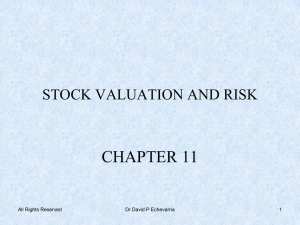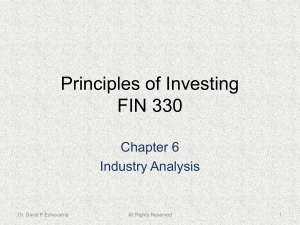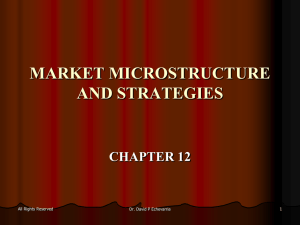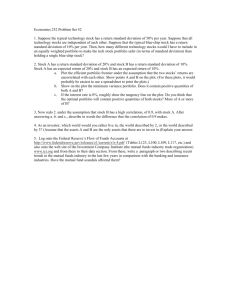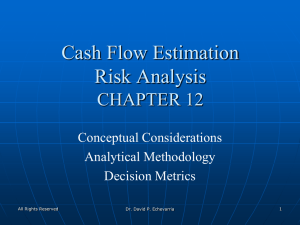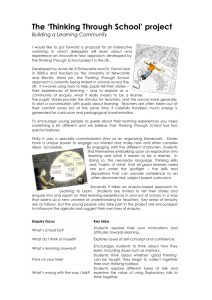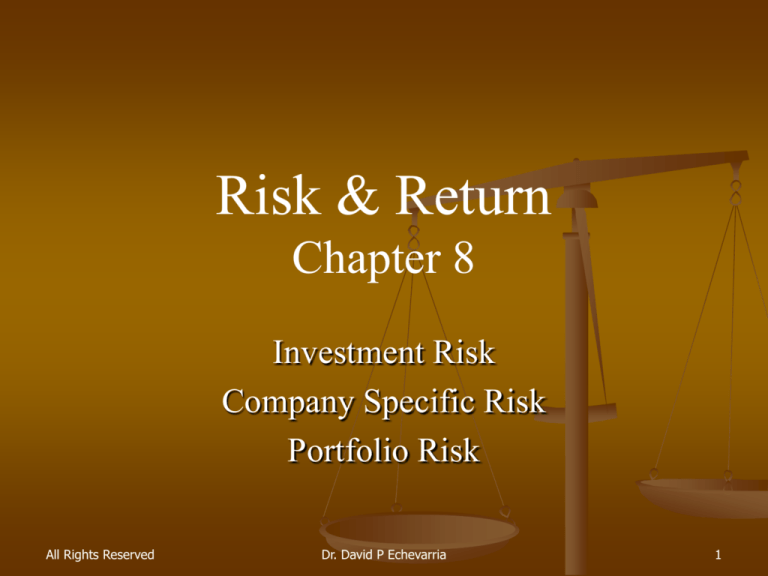
Risk & Return
Chapter 8
Investment Risk
Company Specific Risk
Portfolio Risk
All Rights Reserved
Dr. David P Echevarria
1
Investment Risk
Investment risk is related to the probability of
earning a low or negative actual return.
The greater the chance of lower than expected or
negative returns, the riskier the investment.
Risk is measured as a probability distribution
Mean expected return ( X )
Standard deviation (s)
Note: X and s are sample statistics. m and s are
population parameters (unobserved).
All Rights Reserved
Dr. David P Echevarria
2
Probability Distributions
Firm X
Note: Y is riskier than X
Firm Y
-70
0
15
100
Rate of
Return (%)
Expected Rate of Return
All Rights Reserved
Dr. David P Echevarria
3
Average Returns / Risk 1924 - 2004
Small-company stocks
Large-company stocks
L-T corporate bonds
L-T government bonds
U.S. Treasury bills
Average Standard
Return Deviation
17.5%
33.1%
12.4
20.3
6.2
8.6
5.8
9.3
3.8
3.1
Source: Based on Stocks, Bonds, Bills, and Inflation: (Valuation Edition)
2005 Yearbook (Chicago: Ibbotson Associates, 2005), p28
All Rights Reserved
Dr. David P Echevarria
4
Analysis of Standard Deviations
Standard deviation (si) measures total, or
stand-alone, risk.
The larger si is, the lower the probability that
actual returns will be closer to expected
returns.
Larger si is associated with a wider probability
distribution of returns (e.g.; firm Y)
Standard deviations are scale sensitive.
All Rights Reserved
Dr. David P Echevarria
5
Scale-Free Measure of Risk
Coefficient of variation (CV): A standardized measure
of dispersion about the expected value, that shows
the amount of risk per unit of return.
Standard deviation s
CV
Expected return
r̂
All Rights Reserved
Dr. David P Echevarria
6
Scale Free Risk Comparisons
Average
Return*
Small stocks
17.5%
Large Stocks
12.4
L-T Corporates
6.2
L-T Governments 5.8
U.S. T-bills
3.8
Standard
Deviation
33.1%
20.3
8.6
9.3
3.1
Coeff. of
Variation
1.89
1.64
1.39
1.60
0.82
* Arithmetic Average
All Rights Reserved
Dr. David P Echevarria
7
Investor Attitude Towards Risk
Investors are assumed to be risk averse.
Risk aversion – assumes investors dislike risk
and require higher rates of return to encourage
them to hold riskier securities.
Risk premium – the difference between the
return on a risky asset and a riskless asset,
which serves as compensation for investors to
hold riskier securities.
All Rights Reserved
Dr. David P Echevarria
8
Managing Investor Risk
Primary Strategy to Manage Risk
Holding a diversified portfolio of securities
Stocks (common, preferred, foreign)
Bonds (treasury, municipal, corporate)
Mutual Funds (Growth, Income, Balanced, etc.)
Sources of Portfolio Risk
Firm-specific (diversifiable, non-systematic risk)
Market related (non-diversifiable, systematic risk)
All Rights Reserved
Dr. David P Echevarria
9
HOMEWORK CHAPTER 8
A. Selt-Test: ST-1, parts a, c, e, i
B. Questions: 8-2, 8-4
C. Problems: 8-1, 8-3, 8-6
All Rights Reserved
Dr. David P Echevarria
10
Portfolio Risk
sp (%)
35
Diversifiable Risk
Stand-Alone Risk, sp
20
Market Risk
0
10
20
30
40
2,000+
# Stocks in Portfolio
All Rights Reserved
Dr. David P Echevarria
11
Portfolio Risk – Negative Correlation
Stock W
Stock M
Portfolio WM
25
15
0
0
0
-10
All Rights Reserved
-10
Dr. David P Echevarria
12
Portfolio Risk – Positive Correlation
Stock M’
Stock M
Portfolio MM’
25
25
25
15
15
15
0
0
0
-10
-10
-10
All Rights Reserved
Dr. David P Echevarria
13
Capital Asset Pricing Model
Asset Pricing Theory seeks to explain why
certain assets have higher expected returns than
other assets and why expected returns vary over
time. Expected returns are those returns when
assets are priced in equilibrium:
demand for assets = supply of assets.
Capital Asset Pricing Model
CAPM Measures Risk (b) relative to the Market
CAPM suggests that a stock’s required rate of return
equals the risk-free return plus a market risk premium
multiplied by b (measure of relative risk)
ri = rRF + (rM – rRF) bi
Primary conclusion: The relative riskiness of a stock
(b) is its contribution to the riskiness (Pf Beta) of a
well-diversified portfolio.
All Rights Reserved
Dr. David P Echevarria
15
Market Risk Premium
M.R.P. = (rM – rRF)
Additional return over the risk-free rate needed to
compensate investors for assuming an average amount of
risk.
Price of Risk = (rM – rRF) bi
Its magnitude depends on the stock’s beta (b), the expected
market return and the expected return on the risk-free asset
(i.e., 30-day T-Bill)
Varies from year to year, but most estimates suggest that it
ranges between 4% and 8% per year.
All Rights Reserved
Dr. David P Echevarria
16
The Search for “Alpha”
Regression Estimates: y = a + bx + e
a, the intercept, is also termed the idiosyncratic
return for the random asset y. Investors prefer
stocks with positive alphas.
b, the slope coefficient, becomes the beta of the
pricing equation.
e, is the random error term.

